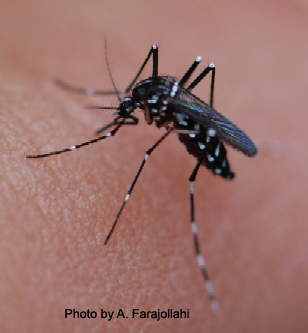I knew that mosquitoes cause diseases like malaria and dengue fever. I also knew that with changes in climate, their distributions are changing. So, I figured it was worth investigating further... with emphasis on Europe, so it has some 'closer to home' relevance.
Mozzies are vectors for a number of diseases including yellow fever, dengue fever, malaria and chikungunya (Akbari et al., 2013). Picking out dengue specifically, approximately 2.5 billion people worldwide are at risk, with approximately 25000 deaths a year (Guzman and Isturiz, 2010).
Aedes aegypti is the principal species facilitating Dengue spread (Halstead, 2008) and it's also responsible for outbreaks of chikungunya (Ligon, 2006). It is native to tropical Africa (Braks et al., 2004) but expanding in range, with Dengue occurrence closely following this expansion (Guzman et al., 2010).
 |
| A female Aedes aegypti, you don't want to encounter one... |
 |
| Notified dengue fever cases by week, Madeira, Portugal, 3 October - 25 November 2012. Source: Sousa et al., (2013) |
Another concern is the Asian Tiger Mosquito, Aedes albopictus, an aggressive species with vectorial capacity for a number of nasty aforementioned diseases.
It is native to East Asia, but is expanding globally at a rapid rate, having colonised every continent bar Antarctica in the past 40 years (Bonizzoni et al., 2013). In the last 10 years the species has been the principal cause of Dengue and Chikungunya outbreaks in Hawaii, Central Africa, southern China and now, Europe too (Bonizzoni et al., 2013). Quite a spread, I'm sure you'd agree.
 | ||
| Aedes Albopictus: currently the most invasive vector species worldwide (Bonnizoni et al., 2013). |
The Tiger Mosquito was the cause of the first notable invasive mosquito-borne disease outbreak in Europe. In the summer of 2007 in Ravenna, Italy, more than 200 cases of chikungunya were reported (Angelini et al., 2007).
It's globetrotting nature presents a threat. Between 1990 - 2013, the number of people living in countries with Tiger Mosquito presence has increased from 3.2 - 5.1 billion. The species is highly adaptable ecologically, can transmit many pathogens and is happy in both urban or rural locations. So, it's not just a globetrotter, it's also cosmopolitan. That could be an issue...
 |
| Global distribution of Aedes albopictus, now available in Western Europe! Source: Bonizzoni et al (2013). |
However, the principal driving forces for the spread of mosquito borne diseases have been anthropogenically driven, due to globalisation and inefficient public health measures (Schaffner et al., 2013).
On the other hand, it is worth pointing out that other invasive mosquitoes such as Aedes Atropalpus and Aedes koreicus currently represent very low threats to European public health (Schaffner et al., 2013).
 |
| Aedes Atropalpus: not as much of a health concern. |
Another invader I came across with the potential to inflict disease upon humans was Nyctereutes procyonoides, or, as we more commonly know it, the raccoon dog. Historically, it was restricted to the Far East, however, it now has a presence in much of northern and eastern Europe, with potential to expand further (Kauhala and Saeki, 2004).
 |
| The Raccoon Dog's native range (blue) and invaded areas (red). |
 |
| Raccoon dogs, cute but be careful. |
To conclude, there is ample evidence that we should be concerned about the impacts of invasive species with regard to human health, particularly concerning certain species of mosquitoes. The growing threat is entwined with global environmental change, anthropogenic and 'natural', as this is permitting the spread of the potential disease inflictors. Should we be concerned? I'd have to say yes, and if we're aware of the threat now, it should help mitigate the effects in the future.
Inspecting Invaders Invasive Species and Human Health Imminent Illnesses in Europe is nice site...............
ReplyDelete